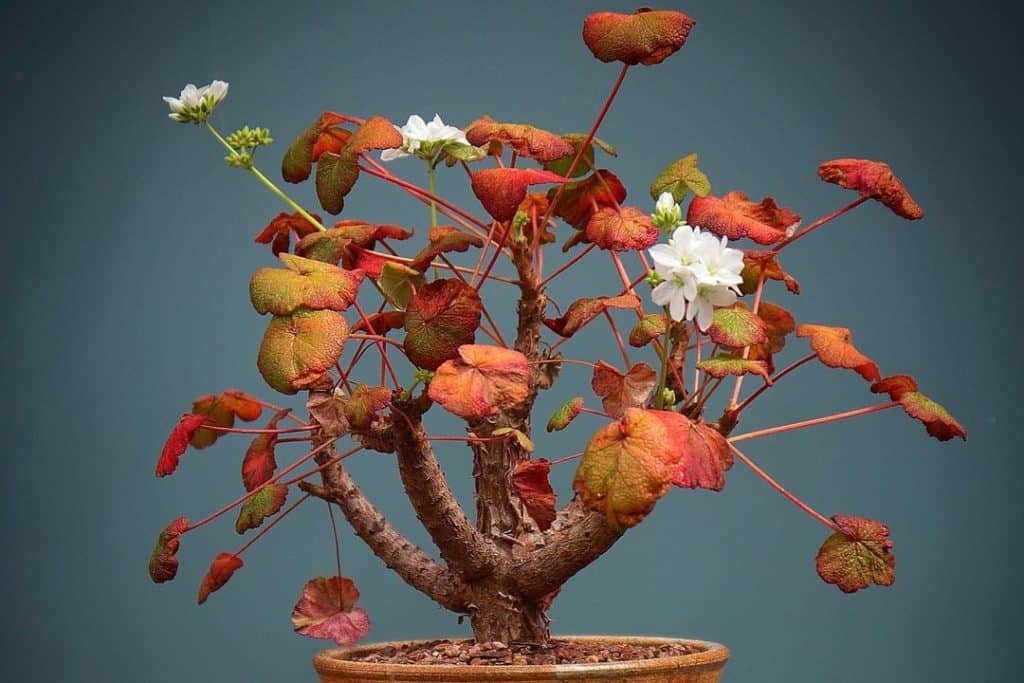Discover the Understated Elegance of Pelargonium cotyledonis
At first glance, you might overlook the humble Pelargonium cotyledonis. But take a closer look, and you’ll uncover an elegant, unassuming beauty that defies expectations. This remarkable plant, a true embodiment of understated charm, is ready to captivate you with its peculiar allure.

Contents
About Pelargonium cotyledonis
Native to the remote island of St. Helena, Pelargonium cotyledonis stands out with its tree-like stature and fleshy, veined leaves that unfurl each summer. Often referred to as the “Old Father Live Forever” or “Hollyhock-Leaved Pelargonium,” this curious succulent blurs the lines between plant and sculpture, demanding a second, lingering glance.
Related Post:
1,000 Types of Succulents [With Pictures]
How to Care for Pelargonium cotyledonis
While modest in appearance, Pelargonium cotyledonis is surprisingly resilient and easy to cultivate, thriving in specialized collections and botanic gardens worldwide. Here’s how you can unlock its quiet splendor:
Light
Pelargonium cotyledonis thrives in bright, indirect sunlight or gentle morning rays, flourishing in light shade during scorching afternoons. Aim to provide at least 6 hours of direct sunlight each day, whether from natural daylight or supplemental grow lights.
If relying primarily on artificial lighting, use a quality full-spectrum grow light positioned about 6-12 inches above the plant. South or west-facing windows are ideal for natural light indoors. Outdoors, choose a spot with morning sun and afternoon dappled shade. This balance of sun exposure allows the plant’s understated elegance to truly shine.

Watering
Exercise restraint when watering this drought-tolerant gem. From early February to late April, and again from early August to late November, provide moderate watering at temperatures above 57°F. During summer and winter’s cooler months, keep the soil fairly dry.
Soil
Contrary to most plants, Pelargonium cotyledonis thrives in a soil mix with minimal organic matter. A gritty, well-draining blend with perlite or pumice works wonders, allowing excess moisture to escape.
Fertilizing
This low-maintenance plant has modest nutritional needs. You can provide a balanced, diluted fertilizer during the spring growing period, but over-fertilizing will diminish its natural character. In most cases, fertilizing is unnecessary.

Temperature and Humidity
Pelargonium cotyledonis prefers warm temperatures, with a minimum of 46°F, even in winter. It thrives in average household humidity but appreciates a boost with occasional misting during dry spells.
Pests and Diseases
When properly cared for, this plant is remarkably resilient against pests and diseases. However, overly damp conditions can lead to issues like rot or blight. The geranium bronze butterfly may occasionally drop larvae, so keep an eye out.
Pruning
Pelargonium cotyledonis has a natural, sculptural growth habit that requires little pruning intervention. Its leaves are present for only a short summer period before self-shedding. However, you can remove any damaged or declining leaves as needed to maintain its tidy appearance. If excess growth develops, judicious pruning can expose the plant’s elegant skeletal structure. But overall, respect this plant’s understated form and prune judiciously only when absolutely necessary.
Potting and Repotting
This succulent appreciates a well-draining pot with ample room for root growth. Terra cotta or plastic pots with drainage holes work well. Re-pot every 2-3 years in late winter before the growth cycle begins.

Pelargonium cotyledonis Propagation Methods
Sharing Pelargonium cotyledonis’ quiet beauty is easy through propagation. Whether you wish to multiply your personal collection or gift these captivating plants to fellow gardeners, the process is straightforward. Follow these simple steps:
From Seed:
- Obtain fresh seeds from a reputable source or harvest from existing plants once fruits ripen fully.
- In spring or autumn, sow seeds shallowly in a well-draining seed-starting mix.
- Provide bright, indirect light and keep soil lightly moist until seedlings emerge in 2-4 weeks.
- Once established, transplant into individual pots using a gritty cactus/succulent potting mix.
By Stem Cuttings:
- Take 4-6 inch stem tip cuttings from a healthy plant, using a sharp, clean knife or pruners.
- Remove the bottom leaves and allow cuttings to callus over for a few days.
- Dip the cut ends in a rooting hormone powder (optional but helps).
- Plant the cuttings in a well-draining potting mix and place in a warm, bright location.
- Keep soil lightly moist and provide humidity until roots form in 4-8 weeks.
- Once rooted, transplant into individual pots and care for as mature plants.
With just a little time and care, you can readily propagate these unassuming marvels, sharing the delight of Pelargonium cotyledonis far and wide.
